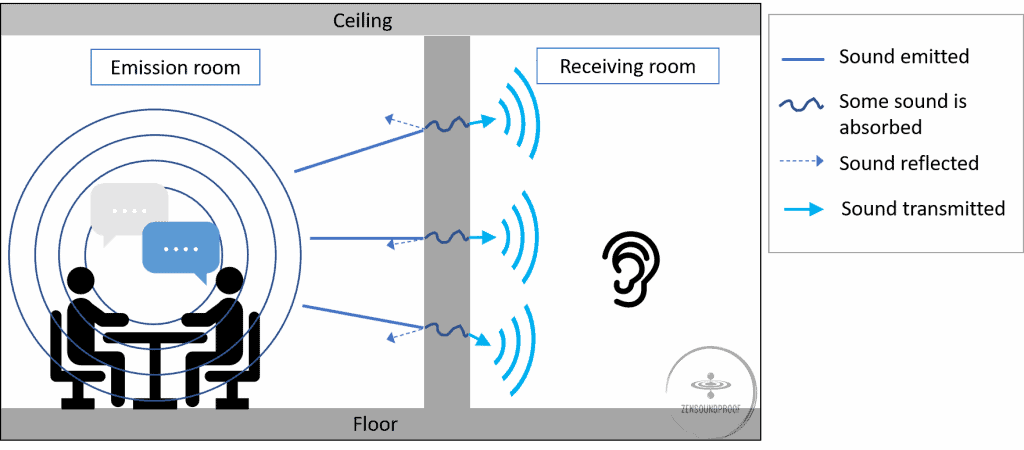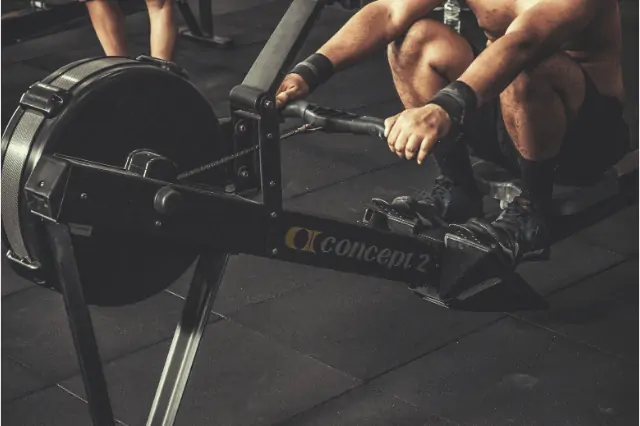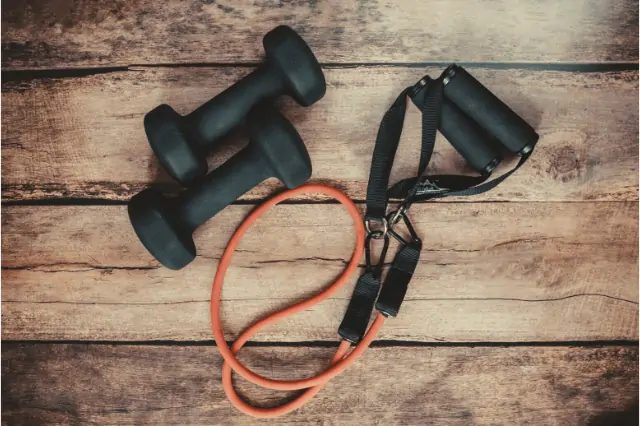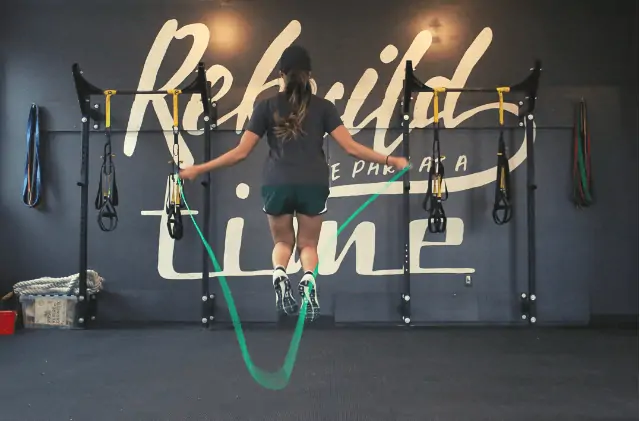Working out in a gym has become risky, and many fitness enthusiasts have moved to a home gym solution. Unfortunately, most apartments have very thin walls and floors. If you want to get along with your neighbors, you’ll have to adjust your workout routine.
We’ve compiled some tips on how to work out in an upstairs apartment. It should help you maintain a great workout routine while keeping the peace.
Common Workout Noises
If you’ve ever been to a gym during peak times, you know how loud workouts can get. Understanding the source of workout noise is the first step to a quiet apartment workout.
Noise comes in two main forms: airborne and impact noise. You’ll need different solutions to control airborne noise and impact noise.
Airborne Noise
Airborne noise is sound that travels, as it names suggests, through air. It includes things like people talking, music playing, and powerlifters grunting. Airborne noise can be heard through thin walls and floors.

For example, your workout playlist is a typical airborne noise. Chances are that your downstairs neighbor doesn’t appreciate your playlist as much as you do. Airborne noise isn’t usually the main source of irritation in this case, but watch out for the volume.
Impact Noise
Impact, or structure-borne, noise happens when two objects collide. This type of noise travels through a solid material, like walls and floors. It can be your feet on the floor, or a medicine ball banging against the walls of your living room. It’s trickier to control than airborne noise. This, because the impact spread soundwaves through the building structure. This means that your neighbor hears almost as much noise as you do.

When it comes to workouts, impact noise is much more irritating. Muffled music is relatively fine, but regular bangs against your floor and walls will cause massive annoyance.
The next time you’re working out in an apartment, take note of the noises you make. Apart from loud music, you probably generate a ton of impact noise from simple exercises.
6 Ways : How to Work Out in an Upstairs Apartment Without Annoying Your Neighbors
1 – Use Mats or Rugs
One of the best ways to reduce impact noise is to use a dampening material like a sound proof exercise mat. These mats use materials like PVC, rubber, or naturally-occurring fibers. All work on the same principle. Their texture absorbs the energy of the impact hitting the floor, and reduces impact noise.
The thicker the noise cancelling mat, the better at reducing impact noise. But there is a point where the mat becomes too soft. It might make simple movements feel difficult and sluggish.

You can go for a specific workout mat like this one. Otherwise, you can add soft tiles over your flooring like this. Don’t hesitate to go to your local sports shop to try different thicknesses. Your shock absorbing mat for exercise is an investment, so feel free to experiment.
A safe option is this comfortable model from Prosource. The mat is 1 inch thick and firm enough with non slip and water resistant features. This makes it an excellent value for money choice.
2 – Pick Rubber Coated Weights
One of the biggest sources of noise in a gym is steel dumbbells and barbells. These tend to clink against each other, which can be annoying to anyone living with you. Also, if you’ve ever dropped a barbell after a set, you know exactly how much impact noise it makes.
If you don’t want to be responsible for a neighbor’s heart attack, use rubberized dumbbells or bumper plates instead. As opposed to a hard material like iron, rubber absorbs some of the force, leading to lower impact sounds. Also, they’re less likely to damage your floor. Combine this solution with a noise-canceling mat for better results.
This resource details the advantages of bumper versus iron plates. It also features a wide range of bumper plate options.
3 – Favor Continuous Movement Machines over Treadmills
Machines, such as treadmills, unfortunately, are a great source of sound. Treadmills are loud due to a combination of moving machine parts, steps, and motor noises. Replace your treadmill with an exercise bike or a rowing machine. They are much quieter while offering similar benefits.

If you love your treadmill to pieces, consider a thick sound dampening mat to reduce impact noise. It should be enough to avoid keeping your neighbors up all night.
4 – Adapt Your Workout Routine
I get it, you’re attached to your own workout routine. Adopting a new (quiet) apartment workout can be daunting. But it’s an affordable solution that will preserve all the benefits from your previous workout.
Some exercises can be an excellent addition or replacement to your former routine. Read more to learn how.
Replace Weights with Resistance Bands
Unless you’re a competitive lifter, you don’t need a lot of equipment to build up muscle. There are plenty of bodyweight exercises that can serve this purpose. Some of these exercises may even compliment your routine, boosting your gains back at the gym.

If you can do dozens of sets of bodyweight squats without breaking a sweat, consider spicing it up. Resistance bands are a great way to include some additional resistance. Unlike traditional weights, resistance bands rely on slow, controlled movements. Slow, isometric exercises allow you to focus on form instead of strength which is tougher than flinging dumbbells around.
Resistance bands are great for apartment-dwellers because they don’t take up a lot of space and are easy to hide. They’re a lot more affordable than a full-on power rack or dumbbell set. Also, you can buy a higher resistance band when you need more of a challenge.
Resistance bands like this one. For a few bucks, it’s versatile and will prove useful in many situations. It includes 5 different resistance levels .
Challenge Yourself with Asymmetric Workouts
Asymmetric workouts like lateral squats or one leg squats can add an extra dimension to your routine. All people have slight differences between their right and left sides. Asymmetric workouts focus on one side of the body at a time, by using a split leg stance, or using differing weights. Unilateral movements have lots of benefits, including:
- Improved core strength
- Better balance
- Reduced dominance of one side
- Improved body awareness
- A quiet way of exercising

If you’re feeling up for a challenge, give asymmetric workouts a try.
Replace High-Impact Cardio with Gentle, Low-Impact Options
If you’ve spent your days running or biking outdoors, quarantine rules have hit pretty hard. While it may be safe to run or bike in an open area, most accessible trails and paths are packed to the brim with people. A safer option is to stay at home and rework your cardio routine.

Bodyweight exercises are a good place to start. At high intensity reps, those exercises are a great cardio and strength workout in one. When it comes to jumping exercises, like skipping or jumping jacks, you have one of two options. Either cut them from your routine and focus on low-impact cardio or learn to land softly.
You can control where a lot of the force of a jump goes. Control the jump by landing on your toes and bending your knees. It will generate a lot less downward force than simply hitting the ground, feet flat. Not only does landing softly lessen impact noise, but it will prevent injury. Once you’ve perfected the silent(ish) low-impact jump, you can continue to enjoy the joys of burpees in the comfort of your home.
5 – Communication!
Don’t hesitate to discuss with your downstairs neighbors, although it can be intimidating. There may be a time where they don’t mind you doing some jumping jacks or burpees (and the crying that follows after).
If you’re lucky, you have great neighbors that don’t mind the occasional workout noise. Remember that this isn’t an excuse to crank up your music up until 11 and start throwing medicine balls around. Even though it’s very tempting to do so.
Everyone is in this pandemic together, and a little consideration can go a long way. Who knows, maybe they’ll even join in – socially distanced, of course.
If you have grumpy neighbors, try to find the time when they go out and take the opportunity to get a good workout.
6 – Soundproof the Floor
If like me, you can’t bear to be without your power rack and love dropping your deadlift weight, you’ll need to spend more and soundproof your floor. A yoga mat and carpets are a great start, but they won’t protect your floor from powerful lifts. For that, you’ll need a permanent soundproofing solution.
Ideally, you want a decoupling agent that stops the soundwave from traveling between the floor and subfloor. You can either build a new floor over your existing floor or tear out your floor and add a new soundproof underlay.

These solutions aren’t cheap and will involve a lot of construction. If you’re committed to a functional home gym for serious, it can be a worthwhile investment.
Final Thoughts
The temptation to sit on your couch all day can be very strong. On another hand, physical activity can do a lot to offset the drawbacks of a Netflix and ice-cream binge. To keep your downstairs neighbor happy, you’ll first need to consider how much noise your workout produces.
Luckily, there are several different ways to exercise quietly. You can either change up your routine, get new equipment, or soundproof your apartment.




